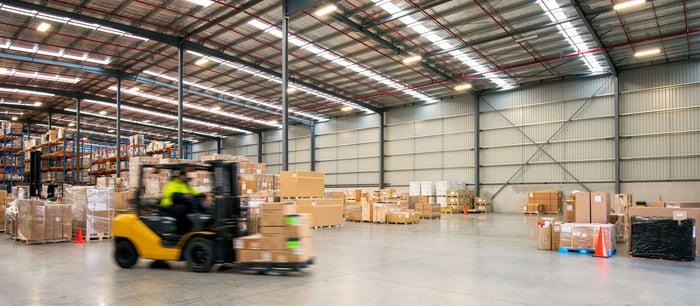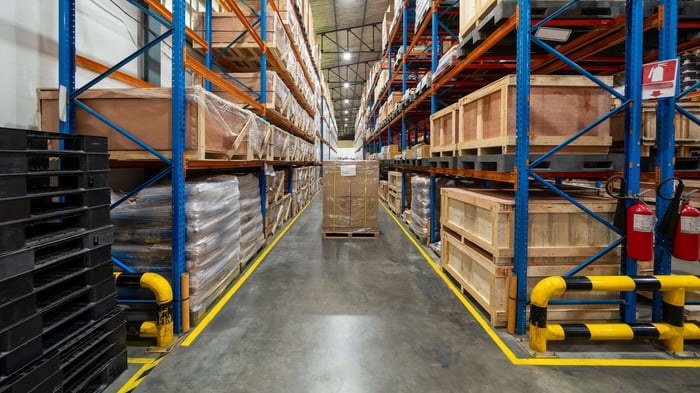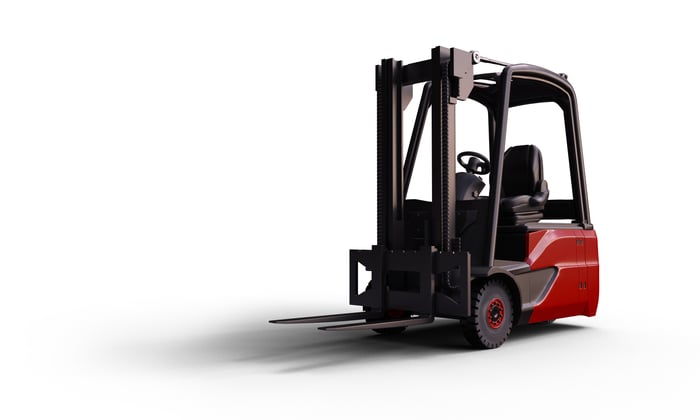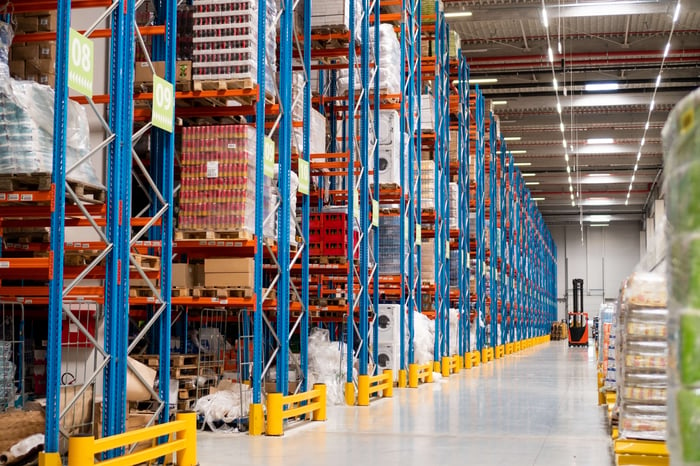In today’s supply chain and distribution world, the warehouse types and warehouse design in which you operate will significantly affect your success. From efficiency to safety, every unique industry and business may benefit from a different type of warehouse layout or operation.
In this guide, we’ll help you better understand the most common warehouse types and how to design your business’ current or future warehouse expertly. So, keep reading to learn everything you need to know about optimal warehouse design.
Warehouse Types to Know
Depending on your industry or product type, your business may benefit from specialized warehouses. Next, we’ll cover the most common warehouse types and how their design supports unique inventory needs, locations, storage requirements, and handling procedures.
1. Distribution Centers
Distribution centers are considered some of the most efficient facilities for rapidly moving products. They serve modern supply chains and excel at expediting the flow of goods from suppliers to customers through automation systems and advanced inventory management technologies.
The warehouse design of a distribution center prioritizes efficient receiving, sorting, and shipping operations, three essential pillars of rapid order fulfillment, and “just-in-time” delivery capabilities.
Ideal For: E-commerce businesses, retail, FMCG (Fast-Moving Consumer Goods), and companies focused on quick order fulfillment.
2. Public Warehouses
Public warehouses are an example of a more versatile solution for new or startup businesses. They offer space without the commitment of owning the facility. These types of facilities are managed by a third-party and operate like shared spaces. Multiple companies can rent the space they need, making them particularly popular for seasonal businesses or those with fluctuating storage requirements.
The beauty of public warehouses lies in their cost-efficiency. Companies share overhead expenses for security, maintenance, and professional management services, significantly reducing individual operational costs.
Ideal For: Small to medium-sized businesses, seasonal storage needs, and companies seeking flexible options without long-term commitments.
3. Private Warehouses
On the flip side, private warehouses are owned or leased long-term by companies for exclusive use. This gives your company complete control over the storage and handling of your goods, including the warehouse design. The beauty of private warehouses is the ability to design your flow, implement customization options, and handle your brand specifically.
Although private warehouse types may require a higher initial investment, they offer potentially lower costs over time for high-volume users.
Ideal For: Large retailers, manufacturers, and companies with steady and high-volume inventory turnover.
4. Smart Warehouses
Smart warehouses are home to the most cutting-edge logistics technology. They’re responsible for innovating traditional storage and handling processes by integrating automation, Internet of Things (IoT) sensors, and advanced robotics—basically, the AI of warehouse design.
These modern facilities leverage artificial intelligence to orchestrate complex operations, from automated picking systems that precisely navigate warehouse aisles to sophisticated inventory management systems that predict stock requirements before shortages occur.
Ideal For: E-commerce giants, companies investing in logistics technology, and those aiming to optimize operational efficiency and reduce human error.
5. Climate-Controlled Warehouses
Climate-controlled warehouses serve as specialized environments designed to protect sensitive goods that require precise environmental conditions to maintain their integrity. These facilities go beyond basic storage by maintaining strict control over temperature, humidity, and air quality – critical factors for preserving items like pharmaceuticals, electronics, fine art, or perishable foods.
The facilities maintain consistent conditions year-round through advanced HVAC systems and continuous monitoring, preventing damage from temperature fluctuations or moisture exposure.
Ideal For: Food and beverage companies, pharmaceuticals, electronics, and industries handling perishable or sensitive goods.
6. E-Commerce or On-Demand Warehouses
On-demand warehouses represent a modern solution to the age-old challenge of finding flexible storage space. They operate much like the hospitality industry's short-term rental platforms but for commercial storage needs.
These innovative facilities allow businesses to secure warehouse space for brief periods through user-friendly online platforms, eliminating the need for long-term lease commitments.
The advantage of this warehouse-type is its adaptability—companies can quickly scale their storage space up or down based on seasonal demands, special promotions, or unexpected inventory surges without the burden of substantial upfront investments or fixed overhead costs.
Ideal For: Startups, businesses with seasonal inventory peaks, and companies expanding into new markets without committing to long-term storage.
Why Warehouse Design Matters
So, why does warehouse design matter? The right warehouse solution can significantly impact operational efficiency, cost management, and customer satisfaction, while the wrong choice can lead to unnecessary expenses and logistical bottlenecks.
As businesses face increasing pressure to optimize their operations and meet evolving customer expectations, selecting the appropriate warehouse type becomes a strategic decision that affects everything from inventory management to delivery times.
Key advantages of careful warehouse design selection:
Reduced operational costs through optimized space utilization
Enhanced inventory accuracy and control
Improved order fulfillment speed and accuracy
Better scalability for future growth
Lower labor costs through appropriate automation
Increased product protection and reduced damage
Improved worker safety and efficiency
Better compliance with industry regulations
Enhanced ability to meet customer service levels
Greater flexibility to adapt to market changes
How to Begin Warehouse Design
First, and foremost, whenever possible, it’s best to work with warehouse design specialists to ensure you get the costly work of designing or re-designing right the first time. There’s nothing worse or more expensive than having to redo the installation of a design after realizing it doesn’t work for your warehouse type.
In general, when beginning to lay the design of your warehouse, you’ll need to consider the following factors:
Nature of your products
Volume of inventory
Turnover rate
Budget constraints
Location requirements
Special storage needs
Level of control needed
Scalability requirements
BMH: The Experts in Warehouse Design
As a business owner or warehouse manager, you’re the expert at managing your company or its inventory. You’re not an expert in warehouse design. Luckily, our team at BMH is. BMH is one of the fastest-growing businesses, helping others select the right warehouse type and design for the smoothest, most efficient, and most profitable operations.
Whether you’re redesigning your current warehouse or moving somewhere new, partner with BMH's experts in warehouse design. Our warehouse design services can help you get the most out of your space and solve common or complex problems such as inventory flow and pinch points.
Contact a location near you to get in touch with BMH and revolutionize the way you work.




